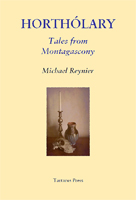The first story, 'The Angel of Pessane', sees Horthólary investigate an apparent murder. The body of an eccentric Englishman (is there any other kind in France?) is found in a forest near the city. The corpse lies in fresh snow, and there are no footprints around the body when it is discovered by local children. The local bishop, Philippe Rapin (the scientific sleuth's arch-enemy) immediately blames gypsies for the supposed crime. But Horthólary sees a very different story in the evidence - or lack of it. To avoid major spoilers I can only say that the story reads like a hybrid of Wells and Conan Doyle, for all its French setting.
In 'Dii Nixi' Reynier takes us back to Horthólary's childhood in a tale that begins with the arrival of a celestial visitor. There's a distinct whiff of Lovecraft about the plot, if not the prose. Reynier's clear, slightly ironic style conveys superbly the vicious rivalry between the local peasant clans, and the way in which the emergence of a weird otherworldly menace affects the destinies of a barefoot Romeo and Juliet. Reynier has a gift for evoking the beauties of untamed nature, and contrasting them with the often grubby ways of our own species.
'The Nephilim', as the title suggests, concerns legendary beings said to inhabit the desolate plateau that looms over Montagascony. Here we find young Horthólary and another student despatched by their tutor to investigate mysterious fossil finds that (contrary to reason, if not scripture) support the existence of giants. What the investigators uncover is not merely startling, it also terrifying, and the price of knowledge proves very steep for one of them.
The final story, 'Nemestrinus', sees Rapin - now promoted to Archbishop - engaged in a heretic hunt that sets him at odds with the aged Professor Horthólary. In all of these stories Reynier makes no bones about the brutality of an era that, in many a BBC costume drama, is often prettified and shown from the perspective of the well-to-do. Here we see the reality of life in a society where the poor are almost powerless and torture is a routine instrument of 'justice'. There is also a very convincing depiction of witchcraft as it might have been (as opposed to how the witch hunters imagined it).
Overall, these stories succeed in evoking Reynier's imaginary province extremely well, and it's refreshing to find that Montagascony's inhabitants are as three-dimensional as its varied topography. There is a wealth of telling detail; thus we learn that Horthólary's father, a clockmaker, wears 'linen shirts several sizes too small for him, a custom adopted so that the cuffs do no interfere with his delicate work'. In addition, the author's wealth of historical, occult, and scientific knowledge supports but never overburdens each plot. These stories certainly qualify as weird fiction of a high order. Reynier's work deserves to be better known.

Note: I received a free ebook from Tartarus for review purposes.




2 comments:
I have seen about two reviews for this book and it looms quite interesting. I am fascinated by the injustice that is directed at minorities, especially those whose beliefs do not conform to the established dogma of a superior; human history is full of such unjust death and cruelties, and people will likely say that about out time in a hundred or so years hence.
Liam
While persecution of minorities is a subsidiary theme, it's certainly never far from the surface. It seems that in 18th century France gypsies were, quite simply, to be driven out of the land regardless of casualties. Throw in the persecution of heretics (in this book represented by the Palbanists, a fictional sect) and you've got a foreshadowing of all the worst excesses of our own times.
Post a Comment